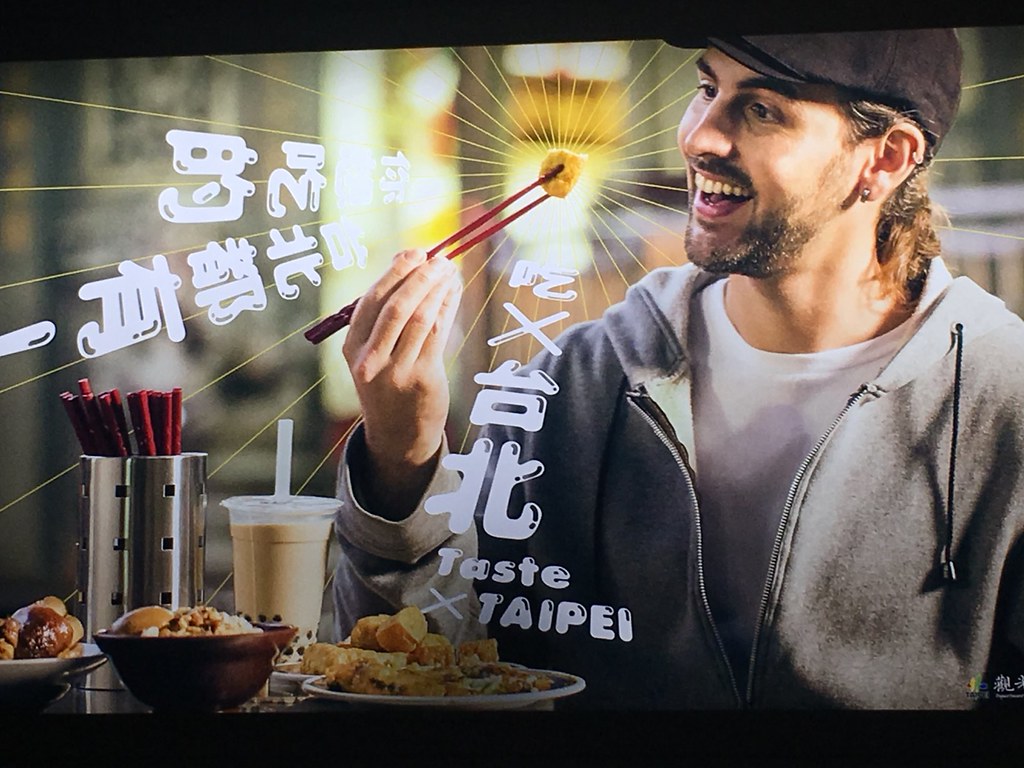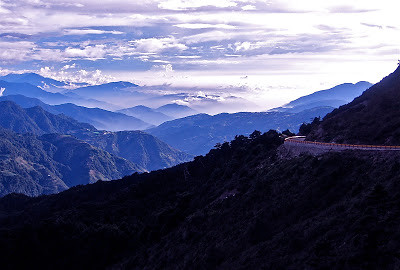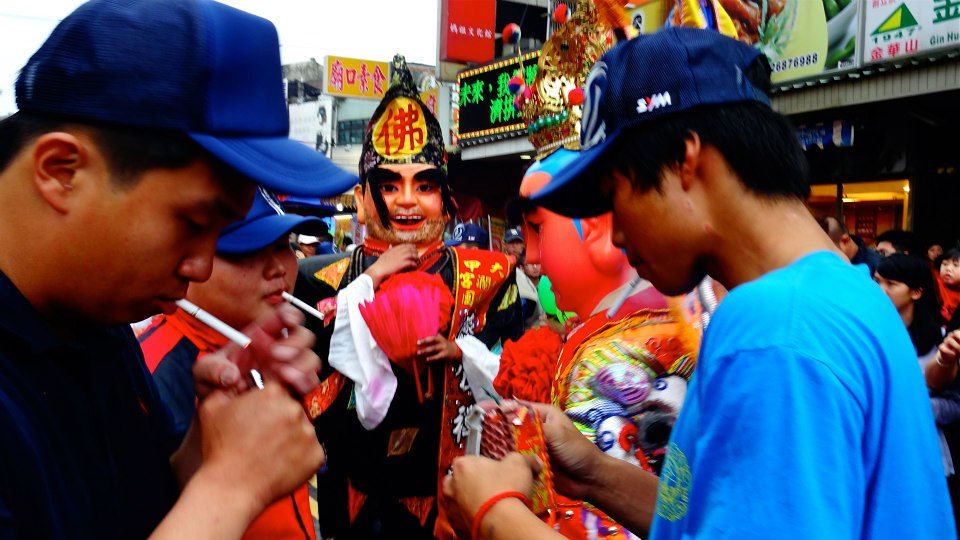 When you think of tourism in Taiwan - domestic and, to some degree perhaps, international - you probably think of at least a few of these:
When you think of tourism in Taiwan - domestic and, to some degree perhaps, international - you probably think of at least a few of these:- Night markets
- Old streets
- Local crafts (e.g. woodcarving or porcelain)
- Regional foods (e.g. 肉圓 in Zhanghua and mochi in Hualien)
- "Taiwanese" culinary cultural icons (think the toilet restaurant and bubble tea)
- Shopping and eating in Taipei, including the massive ATT4Fun and eslite
- Hiking, cycling etc.
- "Cultural creative parks" like Songshan Tobacco Factory and Huashan
- The National Palace Museum
- Tourist destinations like Jiufen, Alishan, Sun Moon Lake, Tainan, Kenting and Taroko Gorge
- (Maybe) Chiang Kai-shek Memorial Hall
- Indigenous festivals and dances
- Temple festivals
Some of these are great - Tainan is unimpeachably fantastic, though perhaps growing a bit gentrified or at least on the cusp of it happening - and the outdoor sports are bar-none amazing.
For the rest, though, slowly and steadily most of the pleasure I might have once been able to derive from them has been chipped away over the years as I seek to learn more about Taiwan.
Night markets are still kinda great, but a lot of the "famous" foods are made famous by savvy promotion rather than actual deliciousness, and with the piling on of food scandals over the years, I can never be quite sure that the snacks I'm getting are safe to ingest.
I appreciate the attempt to preserve the architecture of Taiwan's old streets - and some still do a reasonably good job of this (Hukou, Xiluo and Xinpu are still quite nice, and Dihua Street is still on the right side of fun, although I worry the scales will tip). Yet, a number of them have been turned into shopping drags selling touted "local delicacies" and shop after shop of "traditional items" (think old-fashioned kids' toys and wooden massage implements). They're basically all the same, nothing local or special about them.
Those local crafts? Well...I can't say I'll be buying any Taiwanese wood products or returning to Sanyi anytime soon. And Yingge sells some lovely ceramics, but historically was more known for making bricks, not fine vases.
Regional foods? Michael Turton has already covered that minefield:
All over Taiwan, if you say a city name, like Changhua or Hsinchu, people associate a food with it automatically (ba wan and mi fen). Even foreigners know many of these associations. This attitude is common in Taiwan, but it is rare in the rest of the world....
Why? It’s political, of course. In most countries tourism consists of local history and nature. I grew up in Michigan, where we visited the Upper Peninsula and state parks for nature, and local battlefields and forts for history. No one ever suggested that the state’s prodigious cherry production should be its key association. But in Taiwan, the food association functions to keep locals from associating places with their history, and thus, developing associations with local history that in turn would support and build local identities… Hence, in Taiwan, local domestic tourism is not historical tourism, but food tourism.
I'll add to that some ethical issues: I love bluefin tuna, but...well...hmm. Okay maybe not.
All I gotta say about the toilet restaurant is UGH not the toilet restaurant again, and I do like bubble tea but the aforementioned food safety scandals make me a bit wary of it. Also, it's way too easy to weirdly exoticize it as some Mystical Eastern Thing that Asian People do that Civilized Countries Have Just Discovered.
I'll add to that some ethical issues: I love bluefin tuna, but...well...hmm. Okay maybe not.
All I gotta say about the toilet restaurant is UGH not the toilet restaurant again, and I do like bubble tea but the aforementioned food safety scandals make me a bit wary of it. Also, it's way too easy to weirdly exoticize it as some Mystical Eastern Thing that Asian People do that Civilized Countries Have Just Discovered.
 |
| Hehuan Mountain is gorgeous - and not on the list of "famous tourist sites" in Taiwan (sorry for the low-res photo, I took it years ago and had to gank a low-quality copy from a previous post) |
Let's machine-gun through the rest of that list quickly.
Shopping in Taipei? Eslite is a huge international company, not a plucky local chain (and frankly their selection of English-language books tends towards the pedestrian, and they have a weirdly tiny selection of English-language books about Taiwan). Those Xinyi malls? I've been complaining for years that good local street-side restaurants that give Taipei its atmosphere are being gobbled up into one massive East District food court, and I do not like it one bit. For example, Opa Greek Taverna was great. Then it moved to ATT4Fun, and it's kind of terrible. We never go anymore. The Diner was a lovely place in a lane of Dunhua Road with some outdoor seating (there is still one on Rui'an Street but little-to-no outdoor seats). Now it's a big restaurant in a mall. Blech.
Those "cultural and creative parks" are pretty corporatized and rarely house the most innovative artists in Taiwan. Songshan, for example, has a Liuligongfang (or at least it used to - I haven't been in awhile and it may have closed) and is bordered by yet another eslite.
ALL THE STUFF IN THE NATIONAL PALACE MUSEUM COMES FROM CHINA IT'S NOT EVEN TAIWANESE UGH.
Shopping in Taipei? Eslite is a huge international company, not a plucky local chain (and frankly their selection of English-language books tends towards the pedestrian, and they have a weirdly tiny selection of English-language books about Taiwan). Those Xinyi malls? I've been complaining for years that good local street-side restaurants that give Taipei its atmosphere are being gobbled up into one massive East District food court, and I do not like it one bit. For example, Opa Greek Taverna was great. Then it moved to ATT4Fun, and it's kind of terrible. We never go anymore. The Diner was a lovely place in a lane of Dunhua Road with some outdoor seating (there is still one on Rui'an Street but little-to-no outdoor seats). Now it's a big restaurant in a mall. Blech.
Those "cultural and creative parks" are pretty corporatized and rarely house the most innovative artists in Taiwan. Songshan, for example, has a Liuligongfang (or at least it used to - I haven't been in awhile and it may have closed) and is bordered by yet another eslite.
ALL THE STUFF IN THE NATIONAL PALACE MUSEUM COMES FROM CHINA IT'S NOT EVEN TAIWANESE UGH.
(I mean it's fine to visit if you are interested in Chinese history but don't go there thinking you are going to learn about Taiwan. I generally don't recommend it to visitors who are interested in Taiwan, only those who are primarily interested in China.)
And I don't even think I need to tell you what the problem is with Chiang Kai-shek Memorial Hall.
Temple festivals? Watch out, it's not always what you think.
And are you really sure you want to go to an indigenous festival where you might not be welcome, to see performances by tribes who have been unfairly historically stereotyped as good at three things: singing, dancing and drinking?
And almost all of the famous tourist destinations listed above have been disfigured by tourist infrastructure, with Sun Moon ****ing Lake being among the most degraded. From one side you can't even see the lake from most parts of the town unless you stay in one of the expensive - and often not very good - hotels ringing it (the good ones are very expensive). Taroko is still beautiful, but marred by controversy and a very ugly cement factory with its management that has very ugly morals. Jiufen has lovely views but is so blighted with tourists that it can be difficult to enjoy these days.
And I don't even think I need to tell you what the problem is with Chiang Kai-shek Memorial Hall.
Temple festivals? Watch out, it's not always what you think.
And are you really sure you want to go to an indigenous festival where you might not be welcome, to see performances by tribes who have been unfairly historically stereotyped as good at three things: singing, dancing and drinking?
And almost all of the famous tourist destinations listed above have been disfigured by tourist infrastructure, with Sun Moon ****ing Lake being among the most degraded. From one side you can't even see the lake from most parts of the town unless you stay in one of the expensive - and often not very good - hotels ringing it (the good ones are very expensive). Taroko is still beautiful, but marred by controversy and a very ugly cement factory with its management that has very ugly morals. Jiufen has lovely views but is so blighted with tourists that it can be difficult to enjoy these days.

* * *
So where did that leave me, once I came to these realizations? That everything I liked about Taiwan was a sham? That Taiwan has nothing of interest for tourists? That everything good about Taiwan was invented to keep the country from discovering its real roots?
No.
I was depressed for a time, once it really hit home that so little of what is commonly touted about Taiwan actually embodies Taiwan's strengths, and much of it has been co-opted by forces I'd rather not encourage (like the encroaching uniformity of the old streets and the ghastly tourist infrastructure in scenic spots. I figure themed restaurants aren't hurting anyone). It can be hard to take, learning that things you thought you liked had all of these layers of complexity and undercurrents of problems that make them difficult to keep loving.
I had to tear it all down to build something better - because this country has so much more to offer than sun cakes and Sun Moon Lake. I had to quite literally re-learn Taiwan so I could talk about it for what really makes it great, not just the tourist hype that is so often riddled with problems.
I won't tell people not to go to Taroko or even Alishan (I will generally advise against Sun Moon Lake but if a tourist chooses to go, they might not have an awful time), but I will recommend they go not just to Tainan - god I love that city - but to direct their attention to the national parks, the East Rift Valley, relatively quiet areas of natural beauty like Hehuanshan, Lishan, the Taoyuan grassland/Wangkengtou/Caoling Old Trail part of Yilan, and of course Taiwan's stunning outlying islands. I haven't been to Green Island yet but Matsu, Kinmen, Lanyu Island, Penghu - I love them all. I'll send them to the eastern coast of Pingdong and down to Cape Eluanbi, but have them avoid Kenting itself (there are better beaches anyhow). I'll send them to Lukang, which still has something of a small-town feel, or to explore the smaller towns of Hsinchu county by car. I'll only bring them to Jiufen on a weekday, and if we go I'll insist we hike up to the Japanese shrine above Jinguashi ("yeah you thought Taiwan was Chinese but this ain't Chinese at all"), or approach the town from the Xiaotzukeng Old Trail.
There is so much to see and do in Taiwan - take it from me, someone who's done a lot here, and yet has never actually been to Alishan - that you can have a fantastic time even if you don't go to Sun Moon Lake or buy mochi in Hualien. (Feel free to buy taro cakes in Dajia, just make sure you go to the smaller shops and get them fresh from the oven, stay away from the prepackaged ones which are...fine.)
And it's enjoy the food - just enjoy it for its own sake, eat good stuff where you find it, without buying too much into the "local food as local identity" hype. Some foods really are local - you aren't going to get better milkfish congee than in Kaohsiung, and you can't beat eel noodles or shrimp roll rice in Tainan. You just can't.
I'm still not sure how to promote this Taiwan - the Taiwan I re-learned - to the world. International tourists are more into things like the National Palace Museum than, say, an architectural history of Taipei or learning about Taiwan's vibrant civic engagement, not to mention what Taiwanese history and current political issues have to teach (and warn) the rest of the world. It took years of ripping away beliefs instilled by tourism promotion to see what makes Taiwan worthwhile, a dedication visitors generally don't have (though the number of visitors who come for awhile and end up staying is surprising. We all know that person who'd planned to come for a month and backpack and now lives here full-time, or the one who came to "teach English" [heh] for a year or two and move on who is still here a dozen years later...ahem.)
But now that I know what I've re-learned, I can certainly try.

No comments:
Post a Comment